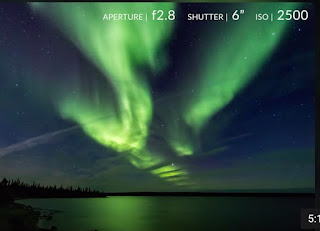This blog is not for others to learn from (yet).
Primarily as a diary of thoughts, ideas, successes, and failures as I learn to do this. Essentially notes to myself.
I have looked for advice online, and my needs are so specific that general advice is not helpful. I will have to do it myself. Probably so much the better.
The inspiration to start astrophotography was a trip we will be taking to Iceland this October. I want to capture the northern lights as best I can. One goal would be to make a short movie of the lights. Of course, much depends on their undependable weather.
So - the Sony I currently have is inadequate to the task- time exposures are not possible, sensor is too small to be very sensitive, etc. The Sony is an excellent, excellent camera in many regards, which I may elaborate on in the future, but not for astro photos.
I purchased a Nikon D750 after much thought. I had 25/80 and 75-300 lenses already from a film camera, and this seemed like the best full frame choice. Having the lenses already was a strong point in favor of the Nikon.
The 25/80, however is only f/3.5 and this may seriously limit the ability to catch the lights.
I may need to buy an f/2, f/1.8 or f/1.4 to do the best I can.
future upgrades may include a motor drive for the DSLR itself.
I have stacking software and this will be helpful in this endeavor.
For now I must practice some night photography, to make my mistakes in Ohio, not Iceland. This website will be very helpful
http://www.davidmarx.com/northern-lights-photography-workshop-equipment-advice/
he says
"My advice for all night photography projects, especially those involving the Aurora Borealis, is to work with a single high-quality wide-angle lens that can gather a lot of light. For the Aurora, in particular, wide-angle lenses with super wide apertures are helpful for two reasons. First, shooting images with a very wide aperture setting allows you to choose a faster shutter speed or a lower ISO setting. Sometimes a faster shutter speed is the difference between crisp images of the Northern Light dancing across the sky or a photo that merely captures blurry streaks and blobs.
https://www.bhphotovideo.com/c/browse/Bags-Cases-Carrying-Equipment/ci/167/N/4075788798
for gear protection, check this out
https://www.bhphotovideo.com/c/browse/Carrying-Gear/ci/2604/N/4075788781
rental lenses?
here:
Primarily as a diary of thoughts, ideas, successes, and failures as I learn to do this. Essentially notes to myself.
I have looked for advice online, and my needs are so specific that general advice is not helpful. I will have to do it myself. Probably so much the better.
The inspiration to start astrophotography was a trip we will be taking to Iceland this October. I want to capture the northern lights as best I can. One goal would be to make a short movie of the lights. Of course, much depends on their undependable weather.
So - the Sony I currently have is inadequate to the task- time exposures are not possible, sensor is too small to be very sensitive, etc. The Sony is an excellent, excellent camera in many regards, which I may elaborate on in the future, but not for astro photos.
I purchased a Nikon D750 after much thought. I had 25/80 and 75-300 lenses already from a film camera, and this seemed like the best full frame choice. Having the lenses already was a strong point in favor of the Nikon.
The 25/80, however is only f/3.5 and this may seriously limit the ability to catch the lights.
I may need to buy an f/2, f/1.8 or f/1.4 to do the best I can.
future upgrades may include a motor drive for the DSLR itself.
I have stacking software and this will be helpful in this endeavor.
For now I must practice some night photography, to make my mistakes in Ohio, not Iceland. This website will be very helpful
http://www.davidmarx.com/northern-lights-photography-workshop-equipment-advice/
he says
"My advice for all night photography projects, especially those involving the Aurora Borealis, is to work with a single high-quality wide-angle lens that can gather a lot of light. For the Aurora, in particular, wide-angle lenses with super wide apertures are helpful for two reasons. First, shooting images with a very wide aperture setting allows you to choose a faster shutter speed or a lower ISO setting. Sometimes a faster shutter speed is the difference between crisp images of the Northern Light dancing across the sky or a photo that merely captures blurry streaks and blobs.
Second, lenses with wide apertures bring more light into the camera’s viewfinder at every aperture setting. The additional light in the viewfinder will not affect your photographs at all but the additional light makes it much easier for the human eye to see details in the camera’s eyepiece as day slips into night. It is much easier to compose a good shot at dusk falls if you can see what you are doing with the camera’s optical viewfinder."
"Samyang lenses are some of the least expensive super fast wide-angle lenses on the market today. All Samyang products are manual focus only but that makes no difference at all when photographing at night."
his recommended lens is a Samyang 24 mm f/1.4 - sold as Samyang, price is $469. Sold as Rokinon, price is $599
For bags, check this outhttps://www.bhphotovideo.com/c/browse/Bags-Cases-Carrying-Equipment/ci/167/N/4075788798
for gear protection, check this out
https://www.bhphotovideo.com/c/browse/Carrying-Gear/ci/2604/N/4075788781
rental lenses?
here:
The sun and you and me and all the stars that we can see
Are moving at a million miles a day
In an outer spiral arm, at forty thousand miles an hour
Of the galaxy we call the 'milky way'
Python, Monty

Comments
Post a Comment